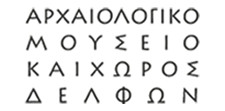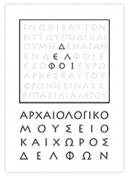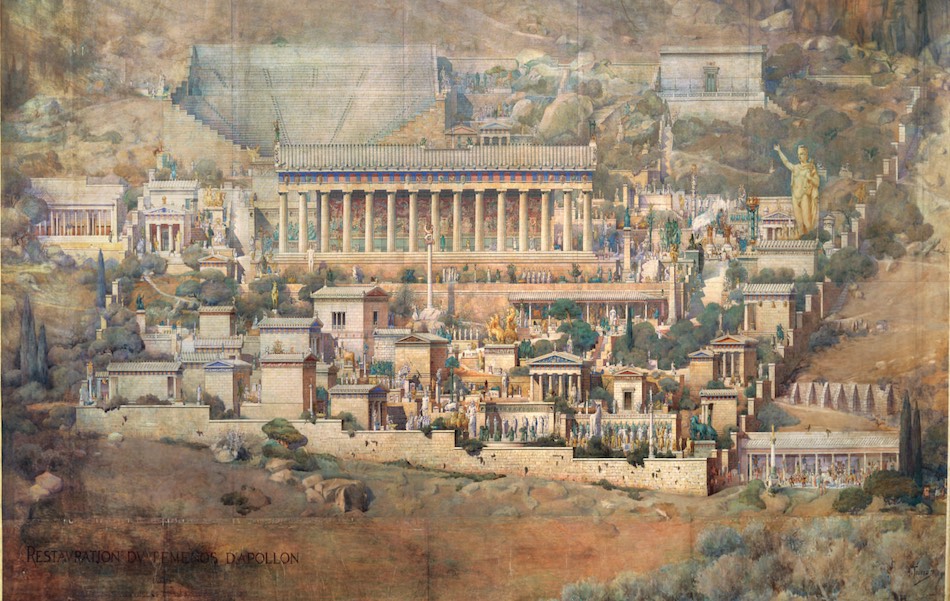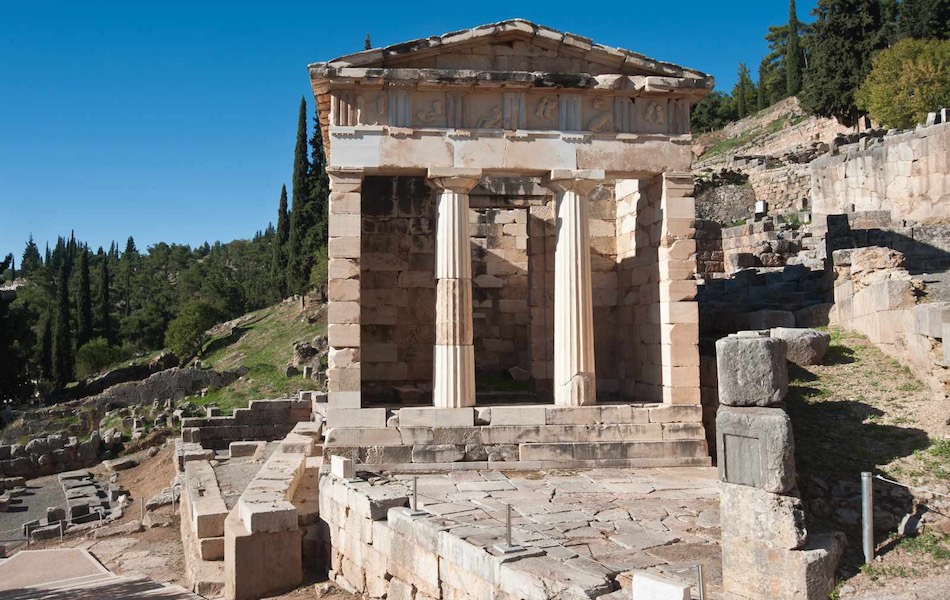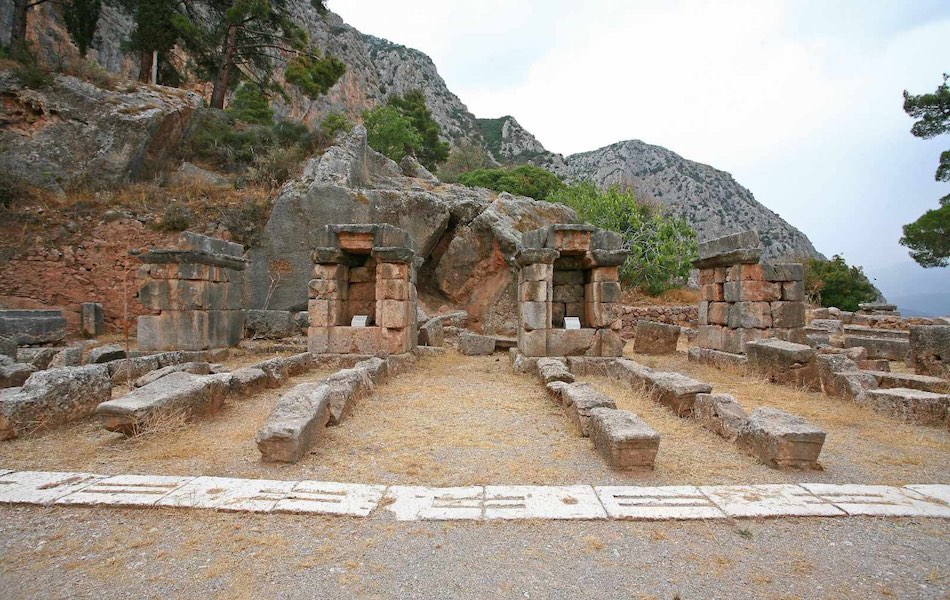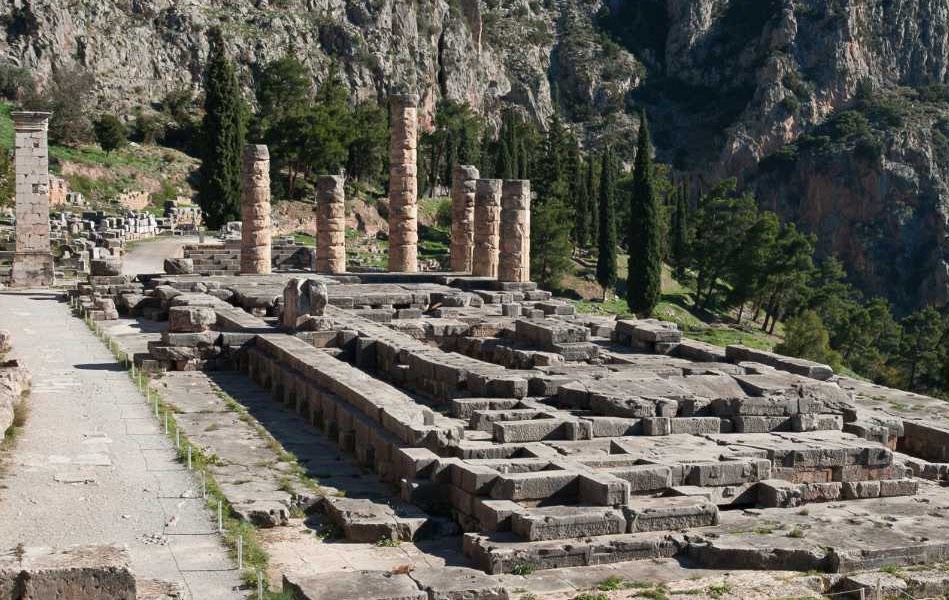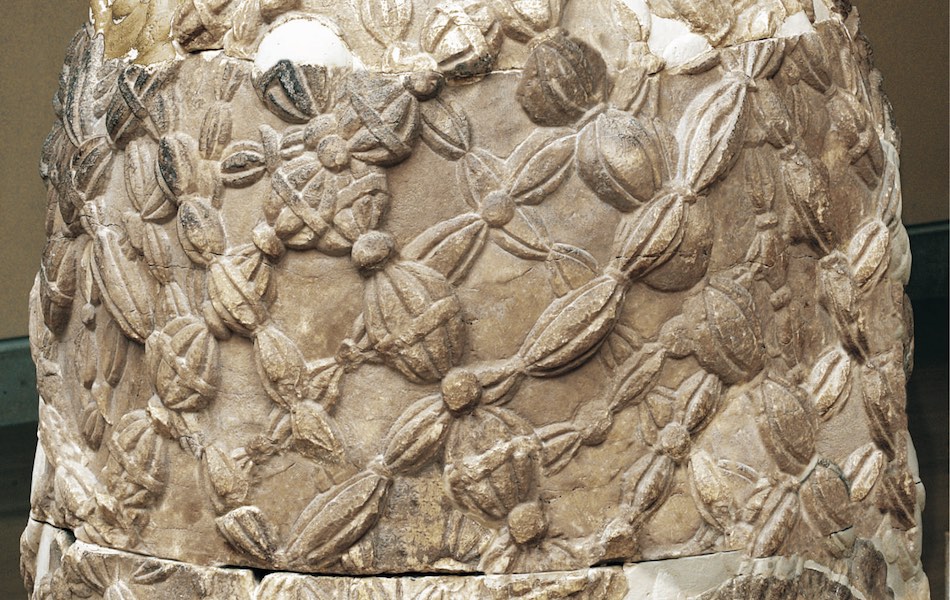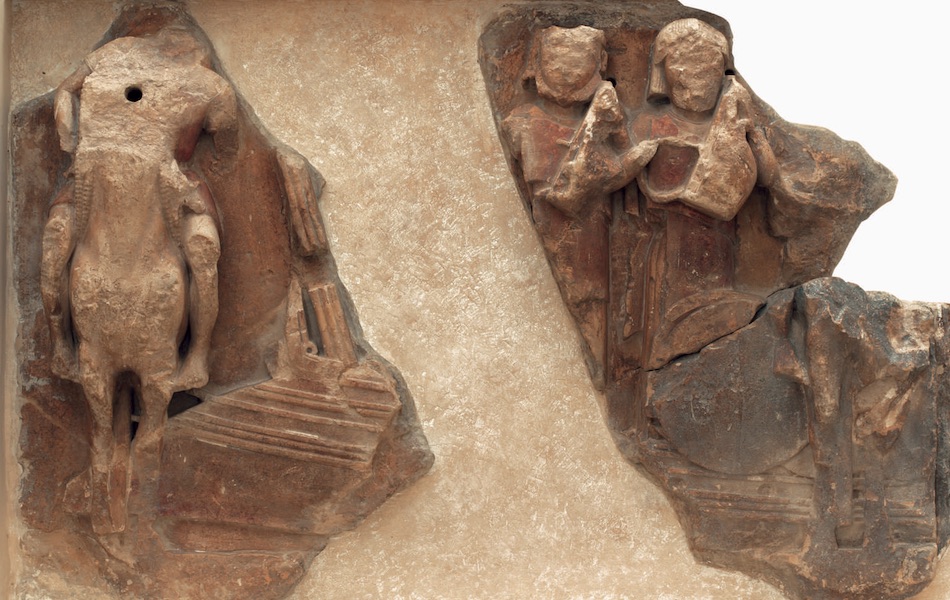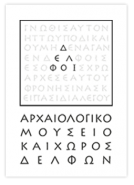Amfissa
The city owes its name to the nymph Amfissa, daughter of the Mythical king Makar, son of Aeolos. Built on a strategic location at the feet of Mt. Giona, Amfissa is mentioned by Strabo and Pausanias. This Locrian city has thrived in the Classical, Hellenistic and Roman period.
The habitation of the city started in the Geometric period. The acropolis and its fortifications are evident and dominating the modern city. In antiquity, Amfissa was known for its rivalry against he Delphic Amphictyony for the control and cultuvation of the Krissaean plain; in the Peloponnesian War it sided with the Spartans.
In the 4th century B.C. the region became the focus of clashes because of the wealth accumulated at the Delphic sanctuary. The 4th Sacred War ended in the destruction of the city by Philip II in 338 B.C. The city was rebuilt, regenerated and it fought along with the other cities of the Aetolian League against he Galatians (279 B.C.) and the Romans who besieged in to no avail in 190 B.C.
After Octavian’s victory at Actium, Amphissa received a number of Aetolian refugees and continued to thrive up to the Frankish period. Then, it became part of the kingdom of Thessaloniki and see of the Barony of Salona (La Sole) under the rule of French noblemen (of the D’Autremencourt family) and then of the Catalan Society. Under the Ottoman period Salona was the see of a kaza, i.e an adminsitrative district. When the Greek War for Independence broke out in 1821, the Greek Orthodox inhabitants revolted and killed the Ottomans who dwelled within the castle. In the region became very active important Revolution leaders, such as Panourgias, Dyovouniotis, Gouras, Athanasios Diakso and the Bishop of Salona, Isaias. In 1826 Salona was reconquered by Kutahi Pasha, who handed it over to Dimitrios Ypsilantis three years later. After the liberation, many Ottoman buildings were demolished. The town planning and architecture of the city was further affected by the earthquake of 1870. However, there are still some houses and fountains to remind us of the Ottoman past of the city.
In Amfissa have taken place many excavations, some of which salvage ones, which have revealed parts of the classical, Roman and Late Roman city. The finds are exhibited in the Archaeological Museum of Amfissa.
The Museum of Amphissa is housed in a mansion of the beginning of the 20th century, which was used as a public building of various kinds until 1987, when the municipality offered it to the Ministry of Culture in the prospect of the foundation of the museum. It is reported that it replaced the house where in 1821 was convened the First National Assembly of the Eastern Mainland Greece. It opened for the public in 2002 and comprises exhibits from Amphissa and from many other sites of the Municipality of Phokis.
In the courtyard are exhibited funerary stelae, pedestals of statues, architectural members and mosaics from late antique houses and early Christian basilicas.
In room A of the ground floor (to the left of the entrance) are presented finds from Kirrha, an important port of the Corinthian gulf and port of Krissa and Delphi.
In the first case are exhibited mainly hand-made pottery objects as well as stone and bone tools, all dated to the Bronze Age. A vessel of the “sauce boat” type of the Early Helladic period, kalathoi, a large two-eared vase with spout, a kantharos of the Middle Helladic period and an anchor-shaped pendant count among them. A stone pestle and mortar were probably used for grinding cereals.
Stone axes, obsidian and flintstone blades, stone loomweights and some bone tools (one possibly used for weaving) are also presented.
In the next case one can see pottery of the Middle Helladic period, of the so-called Minyan type, with grey or reddish surface. The types appearing in Kirrha are the tall stemmed kylix, the two-eared cup, the large, open, bell-shaped vessels, the kanthar and the single-handled ladle or cup. Particularly interesting is a cup with sieve. Vessels of the same period are displayed in one more case: unpainted kalathoi, small cups and beveled jugs, as well as a large two-eared vessels with the distinctive decoration of a wavy line along the shoulder.
In a separate case is displayed a large number of painted shards of the Middle Helladic and the Mycenaean period. Although fragmented, they do contribute to the understanding of the evolution and the variety in decoration of the pottery from the simplest and single-coloured geometric patterns in the older periods to the most elaborate ones as time went by, up to the form of a horse with inlayed white colour on the last one.
In the rest of the cases are presented Mycenaean vessels, among which several tall stemmed kylixes and low conical mugs, a stirrup jar, an askos and a three-eared alabaster, large mugs with spouts as well as two figurines, one of the «Ψ» type with raised hands and an animal-shaped one. Particularly interesting is a rhyton, which imitates exactly a pig’s utricle.
In another case of the same room are presented some of the numerous clay figurines found in the late archaic sanctuary of Kirra, dating mainly in the Archaic and the Classical period. Some of them are in the shape of a woman’s head or bust, often bearing a tall headcover and following Corinthian or Parian models. Among the rest stand out the types of an enthroned female deity, the type of standing Artemis holding a deer and a bow or that of the Kore who holds a bird and a pomegranate.
There are also tiles with seated female figure and some other ones cut around the contour, which depict a sphinx with tall headcover and a Gorgo running with raised knee.
A rare bronze deer was possibly a handle to a metal vessel. Simulations of fruit (pear, grape) and animals (pig, turtle), numerous tiny cotylae, as well as other types of miniature vessels (hydria, amphora, kantharos, wine jug, lekythos) are also on display. Particularly interesting is the head of Artemis with a tall headcover from a marble statuette dated to the end of the 4th century B.C.
Among the rest of the finds stand out the Corinthian lekythoi with rosettes dated to the 5th century, the Attic black-figured lekythoi, a black-glazed oil lamp with many spouts and a wine jug of the 5th cenruty B.C. with finely incised ivy branch on the shoulder. However, a vessel which really stands out is the closed red-figured kylix attributed to the “Karlsruhe painter”, dating to ca 475-450 B.C. and bearing a Dionysiac scene on the outer surface and a figure of a young man wearing a wreath on his head and playing the double flute; its upper surface follows the white ground technique.
The concluding exhibits of this room are the metalling finds, a Mycenaean sword of the type CII and some daggers, a buckle with spiral ends and a brooch with two horseheads. In the same case are to be seen stone and bone beads from necklaces.
In room B (to the right of the entrance) are exhibited sculptures from Kallion, the ancient Locrian city which in its largest part was inundated by the water of the dam lake of river Mornos. A statue of Persephone stands out: she wears a chiton and himation and dates between 310 and 290 B.C. Next to it stands a bearded man’s head and a torso of Artemis, a Roman copy of the Artemis of Versailles type. Furthermore, a relief of a young man wearing a himation from a funerary stele is displayed.
Room C comprises finds from Itea, Lilaea, Potidaneia (Kambos) and the sanctuary of Demeter Erochos at Polydrosso. From Itea comes a crater, a hydria, an amphora, a stirrup jar and an alabaster, all dated to the Mycenaean period, as well as a wine jug of the Geometric period.
From Krissa come mainly Mycenaean vessels. Particularly interesting are the 22 incised Mycenaean gems with depictions of animals, which were worn as talismans or necklace beads or even bracelets.
The finds from Lilaea comprise also plain ware (jugs and mug of the 7th and 6th century B.C) as well as seveal bronze items of the Geometric and Archaic period, namely a diadem, beads of a necklace in the form of birds, brooches and pins with disc or lotus blossom head, rings and bracelets. The group is complete with two copper phialae, handles of cauldrons and several bronze decorative parts of wooden boxes. Some of them are cut around lamellae in the form of human faces and a Gorgo face. All these items date to the 6th century B.C.
Among the other Lilaean finds count also a black-glazed Attic kylix depicting a maenad, some clay figurines of female busts and a standing female figure as well as two stamped rooftiles with the name “Lilaeon”. Finally, some finds come from the sancturay of the river god Kephissus, namely the hand and head of a marble statue of a girl, dated to the 3d century B.C.
In the case which comprises finds from tombs in ancient Potidaneia stands out a bronze helmet of the Attic type with sideburns decorated with a shield bearing a star, dated to ca 300 B.C. The same cemetery has yielded Early Corinthian aryballoi, as well as few golden pieces of jewellery of the 2nd century B.C.
On the staircase leading to the upper floor are exhibited in niches two little marble statues of Pluto with a Cornucopia and of Aphrodite with a little Cupid. There is also a fragment of the funerary stele with the archaic inscription «Λεύκιπ(π)ος».
The upper floor has a different thematic division comprising finds mainly from the city of Amphissa, as well as from other regions such as Kallion, Agia Euthymia and the sanctuary of Demeter Erochos.
In the first case is displayed a clay statue of a young satyr, found broken in many pieces and conserved. It comes from Kallion and dates to the Hellenistic period. The young satyr wears an ivy wreath on his hair, a short chiton and a skin on his breast. With his right hand he pours a libation out of a kylix whereas with his lifted left hand he would probaby hold a thyrsos. It is the work of a local or provincial workshop, but it is quite lively and fresh in conception, reflecting the art of the late Hellenistic period.
Next comes tht torso of a little marble statue of Aphrodite, dated to the 3rd century B.C., an Attic black-figured lekythos of the early 5th century B.C. and a black-glazed Boeotian wine jug with a trefoil mouth dating to the 6th century. It depicts a kneeling satyr, kindling the fire on an altar.
The next entity comprises architectural elements. A variated Corinthian capital dates to the end of the Hellenistic period and next to it a plain or unfinished capital made of grey poros stone (4th century A.D.)
On the adjacent case are displayed bronze nails and clay water pipes from Amphissa. The next case comprises items related to the furnitures of the houses (fragments of decorative elements made of bone or metal). A bronze pyxis in the form of a miniature larnax and a depiction of a mythological scene in relief.
Terracotta oil lamps were used for lighting, as the Roman ones displayed and bearing the names of their potters. The black glazed ones on the upper shelf date to the Classical period, whereas some more date to the Hellenistic and Late Roman period.
The next case is related to nutrition, which is highlighted with a pestle for cereals, sea shells, figurines of animals and birds (pig, cow, rooster, ram), the preserved shell of an egg and a rare model of a grill or platter with fish.
The men’s world was dominated by war and its peaceful symbolic expression, namely sports. In a case are presented Classical metal swords and lancets from Agia Euthymia and a dagger from Amphissa. A black-figured Archaic kylix bears the depiction of a battle scene whereas on a black-figured olpe of the same period is presented the moment when the warrior wears his greave. Warriors are depicted on Corinthian aryballoi, which contained oil for anointing the athletes who would then clean their body with strigils, like the ones exhibited here.
On the other hand, the women’s activities were related to household needs, as depicted by the figurines of women bearing hydriae in the next case as well as the apparatus for spinning wool, coiling threads and weaving. Two of the loomweights displayed here are decorated with an anthemion and a star. Part of the female world was the game of shanks and it looks like the kneeling female figurine of the exhibition is doing exactly this. Women used mirrors made of metal (the terracotta model of a mirror was probably used as a grave good) as well as make-up powder mixed within sea-shells, whereas the pins and brooches had both a functional (i.e. fasting clothes) and a decorative use.
Various accessories, such as bronze beads, kept in terracotta or wooden pyxis-type vessels, completed their attire.
The following cases comprise figurines and jewellery, depicting all possible kinds of dress and hairdo. Among the jewellery pieces stand out the pins with a head in the form of disc, the 8-shaped spiral or bow-type brooches as well as the Boeotian brooches with a square, incised tile. They all date to the 8th century, as well as the bronze beads and pendant in the form of a fruit or bird.
The figurines represent women in peplos, wearing a chiton or a chiton and a himation. One of them holds a wicker fan. In some cases the end of the peplos covers the head like a scarf. On the lower shelf are displayed over 800 little heads of figurines of the 3rd and 2nd century B.C., which were found in the playground of Amfissa. Their hair styles are particularly interesting. Bronze and golden spirals were used for fasting and decorating the hair. Among the rest of the jewellery stand out bronze rings and golden earrings (a pair with figures of little Cupids), whereas a golden ring and a golden pendant decorated with red granate date to the 2nd century B.C. A golden wreath made of lance-shaped trilobe leaves is of a similar date.
The next case represents the world of the children, with usual toys such as figurines of animals and birds, an articulated doll, feeding bottles and a small lekythos with the depiction of a crawling toddler.
Similarly, there are worship themes with kernoi, composite vessels used for offerings, a figurine of a woman preparing herself for a libation and two large bronze phialae (libation bowls) dated to the Archaic period. The one on the right bears a leafy decorative motif in the type of a flower calyx.
Τheatrical acts were related to the Dionysia cult, in which tragical and comical masks were used, such as those depicted in the miniature models of the next case. Furthermore, figurines and dancers and actors dated to the Hellenistic period fall within the same theme, and so does the fragment of a bone flute and the lead lamella with Apollo playing the Guitar.
Public life is represented by the particularly interesting clay stamps of documents, found in the House of the Archive at Kallion [fotooikiaarheiou]. Their figurative representations are often inspired by well-known coin types. Two fragments of rooftiles bear a stamp with the name of Lysipon, head of the council of the Locrians in the 2nd century B.C.
A group of bronze medical instruments from Amphissa comprises lancets, tweezers and tiny spoons for measuring powerful drugs kept in pyxis and glass unguentaria. Similar in context is the next case with instruments made of bone, sceletal finds of people who died by diseases and figurines of pregnant women as well as of a Telesphoros, a child deity with a covered head, related to successful labour.
The potter’s workshop case presents various types of glazes and polishes of the surface of vessels, with imported as well as local examples. Black-glazed, black and red vessels, with painted, embossed or relief decoration, an oil-lamp with the signature of the potter Neikander, vessels with faulty firing, as well as figurines with large openings at the back in order not to burst in the kiln. Broken vessels were often repaired with lead joints as the ones displayed in the same case.
In the next case are displayed vessels of various types, techniques and date: prehistoric, geometric, hellenistic and roman cups, black-glazed fluted kanthars and added parts of clay in the form of tendrils, classical jugs with vertical flutings, geometric jugs with horizontal lines, unglazed amphorae and black glazed pelike, megarian scyphoi of the 2nd century B.C., a trade amphora of the same date, rescued from the sea, an amphora of the Forlimpopoli type (Roman period) and a black glazed double askos with an incised decoration of the 3d century B.C. Its interior is divided in two compartments for oil and vinegar, pouring out of the opposing spouts. Another lentil-shaped askos, also of the Hellenistic period, was probably used as a water bottle.
The bronze vessels are limited in number and include a pear-shaped sprinkler and a wine jug with trefoil mouth in the form of an acanthus sprout (end of 4th century B.C.), a deep, undecorated phiale and a tall aryballos of the 1st century B.C. or A.D. A Corinthian helmet of the 6th century B.C. from Agia Euthymia and some small fragments of bronze statues of the 4th century B.C. from the sanctuary of Demeter Erochos are also specimens of the metalworking prowess. Finally, the large number of bronze Geometric hoops from the same sanctuary, probably constitued an early form of coinage.
The numismatic collection, on the other hand, is exhibited in a separate room with an educational character for the history of coinage. It comprises numismatic treasures from Phokis, coins from various sites and the entire numismatic collection donated to the museum of the collector from Amphissa Drosos Kravartogiannos.
MUSEUM OF DELPHI
